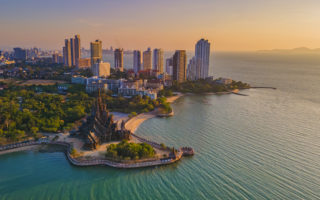
Sanctuary of Truth, Pattaya, Thailand during sunset seen from a high angle view from drone
It’s not really just one part of the world where people are seeing worsening problems with air pollution.
In most developed and developing countries, we’re seeing people trying to address smog and emissions. They look at dirty air, particularly in cities, but also in other areas as well. It’s a problem everywhere.
A combination of factors contributes to this problem. More traffic, for example. There’s also more industrial activity, more development, and more wildfires caused by changes in weather patterns.
Let’s look at what they’re doing in Thailand, where smog is a major issue.
Noting that air pollution affects millions there, a recent news article by Sally Jensen and Watsamon Tri-Yasakda shows how Thai authorities are trying to tackle the problem.
Ice in the Sky
Essentially, the method here is for airplanes to go up and drop either dry ice, or natural ice and water. They do this in order to cool down air zones far above the ground level.
The belief is that this is going to have an effect on pollutants. These elements disperse in the cooler temperatures. Scientists have called these ‘warm weather holding scenarios.’ Increases in temperature lead to pollutants being trapped up there in the atmosphere. Those pollutants need to be dispersed to make the air cleaner, but they stay immobile.
Some refer to this as “temperature inversion,” and that’s why Thailand is using airplanes this way. Officials want to mitigate the effects of the pollution itself.
The Royal Rainmaking Department
Jensen and Tri-Yasakda’s article references something called the Royal Rainmaking Department. That’s something most Americans have probably never heard of. It has an interesting name.
Digging into the details, you can see that this department previously existed to try to deal with drought conditions and handle water needs.
If you search for information about the Royal Rainmaking department, you’ll get answers like this explaining the history of this government agency:
“Thailand’s Royal Rainmaking department is part of a government-backed initiative—commonly known as the Royal Rainmaking Project—established to help alleviate drought conditions through artificial rain induction. Initiated during the reign of King Bhumibol Adulyadej, the project uses cloud seeding techniques to encourage rainfall, thereby improving water supplies for agriculture, industry, and domestic use.”
Going back to the air pollution program, you can see that they’ve multitasked this agency to work on the project of dispersing contaminants.
Measuring PM 2.5
Reporters note that this process is not proven to help with smog or air pollution.
However, they also point out that part of the program involves a second airplane. This plane is coming directly behind the seeding plane (and also flying a pre-seeding mission) to measure PM 2.5 both before and after applications.
Officials found the numbers to be different. That suggests that this approach is effective and useful.
However, some still have doubts.
A Band-Aid
Oil and gas companies have contributed to the practice of dropping dry ice over Thailand. Some officials contend that this is greenwashing, or in other words, “cilantro.”
Here’s this from Jensen and Tri-Yasakda’s article:
“Weenarin Lulitanonda, co-founder of Thailand Clean Air Network, accused the energy firms of ‘using cilantro to garnish their dish’ – the Thai idiom, she explained, meant that ‘instead of solving the problem, (they) are creating a beautiful image’”.
Detractors also note the cost of the program, where one flight can reportedly cost around $1500.
In any case, measuring the PM 2.5 is an effective way to look at the outcomes in terms of air pollution. We explain to our customers that PM 2.5 consists of small particles. These can get trapped in the lungs. They may cause health conditions over time.
The above is just one way that a nation decided to deal with its air pollution problem. On the blog, we’ve also recently highlighted U.S.-based programs in places like Oakland and Denver, Colorado. In these places, people are getting serious about addressing the health risks associated with contaminants.
Protecting Your Home
In addition to making air cleaner in your community, you can really improve the air inside your home, or in your workplace, where you spend a lot of your time.
That involves putting an air monitor in place that will help you see what’s lurking in your indoor air. This is kind of like what the Thailand operations are doing with the airplanes that are doing the air evaluations.
After you know what you’re dealing with, you can get an air purifier machine that will capably remove items like this from the air inside your house. You could check out the AustinAir Healthmate, or the Ideal Pro AP40 for good overall filtration. Another top choice is the AirPura r400.
That’s the basic process, but there’s more to it than that. US Air Purifiers LLC can help customers with getting the right machine, and be confident about what they’re purchasing for protecting their health in the future. Let us help you to explore all of the new models and technologies on the market, and make the right choice.